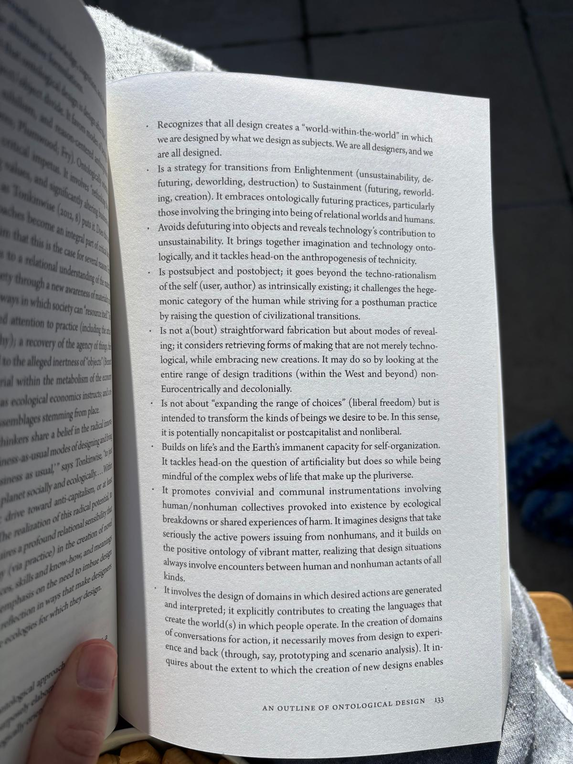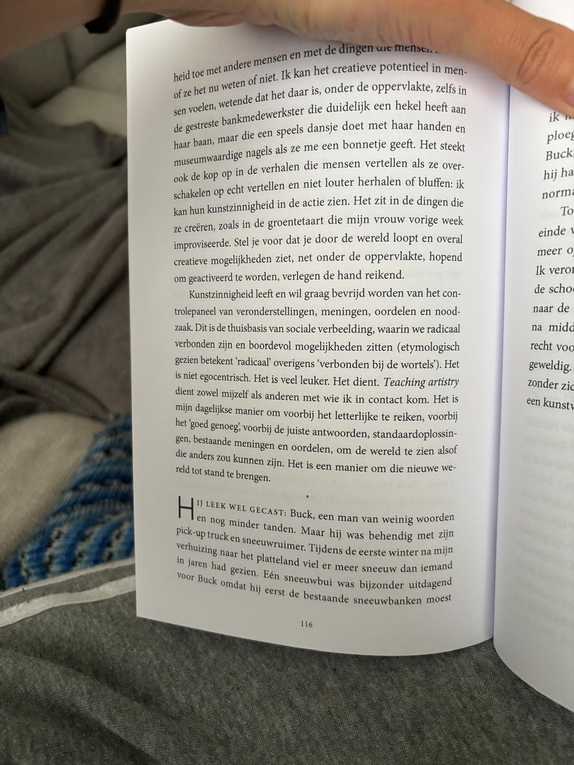Designs for the Pluriverse
Arturo Escobar, 2018
ISBN 978-0-8223-7105-2 (paperback)
Status: Gelezen (volledige boek). Maart 2025.
Niet relevant voor onderzoek momenteel
Notities:
pluriverse meaning a world where many world lives (preface acknowledgement xvi)
“[...], all creation is collective, emergent, and relational; it involves historically and epistemically situated persons (never autonomous individuals), and this ineluctable relationality is acknowledged now by designers in the age of “design, when everybody designs,” [...]” (preface acknowledgement xvi)
“We restate the question: can design be reoriented from its dependence on the marketplace toward creative experimentation with forms, concepts, territories, and materials, especially when appropriate by subaltern communities struggling to redefine their life projects in a mutually enhancing manner with the Earth?” (preface acknowledgement xvii)
The design that the book refers to is “much more than the creation of objects (toasters, chairs, digital devices), famous buildings, functional social services, or ecologically minded production. What the notion of design signals in this work - despite design’s multiple and variegated meaning - is diverse forms of life, and often, contrasting notions of sociability and the world.” (p. 3)
Four reflections on design being “The first is the ubiquity of design - design is literally everywhere; from the largest structures to the humblest aspects of everyday life [...]. Second, social context is important for successful design, well beyond products’ function or commercial application, or for effective services. Third ecologically oriented fields [...]. The fourth signals what is perhaps the most radical change: the need to take seriously the notion that everybody designs, leading to a whole range of proposals for ethnographic, participatory, and collaborative design and indeed rethinking the entire concept of design “when everybody designs,” as Italian design theorist and practitioner Ezio Manzini pronounced [...]” (p. 2)
On ontological design: “Ontological design stems from a seemingly simple observation: that in designing tools (objects, structures, policies, expert systems, discourses, even narratives) we are creating ways of being. A key insight here is what Anne-Marie Willis (2006, 80) has called “the double movement of ontological designing,” namely, that we design our world, and our world designs us back - in short, design designs.” (p. 4)
On race, gender, class and coloniality. Also Foucauldian terms and a designed society (p. 58)
Design as politics and ontologically design as a possible future (p. 59)
The diversity of the world is infinite, what doesn’t exist is actively produced as nonexistent or as a noncredible alternative to what exist, and the understanding of the world is much broader than the Western understanding of the world (p. 68-69)
The belief in the individual is damaging. Colonialism, modernization, and globalization being a Trojan horse in communities. One man’s mission that destroys, (p. 83, nederst)
Explaining what ontological design is (p. 110-111, 116-117)
Final outline of ontological design (p. 133)
Method meets art. Art based research practice. 2nd edition
Patricia Leavy, 2015.
ISBN 978-1-4625-1332-1 (paperback)
ISBN 978-1-4625-1944-6 (hardcover)
Status: Kapitel 7 en 8 gelezen. Maart 2025
Notities:
Photo essay (p. 226)
Humans are social beings. Human experience cannot be understood seperately from the enviorment (p. 230)
Visual arts-based participatory methods (p. 232). Point of departure for dialogue. Aesthetics becoming salient.
Photovoice to record circumstances and enviotment of participants (p. 234)
Art journaling. Participants create a piece of art on a particular topic or theme (p. 241)
A synergistic practice. Fit between the research goals and the methods employed. The creative proces and follow up can be an empowering experience for the participants as well as allowing them to retain control. (p. 242)
Visual field notes made by the researcher to for example capture reflections of an observation (p. 244)
Checklist of considerations (p. 246)
Visual portraits: portraying richness and complexity. Researcher portraying participants, their stories, thoughts, personalities in a creative way (p. 255-261)
Art-based-research isn't only for artists (p. 264)
When researchers use their own experiences as a part of data collection, there may be a tendency to collect too much data (p. 269)
Translation of data in one medium to another medium (p. 270)
Aesthetics and artfulness (p. 277-279)
Issues of ownership and copyright (p. 282)
Presentatie: Gert Biesta
https://vimeo.com/268735232?&signup=true#_=_
Status:

